|
In order to help decide which
structures should be kept in the Park following the conclusion
of the Fair, a Committee headed by William F. Shea, Director of
the Budget, was appointed by New York Mayor Robert Wagner in February,
1965. Working closely with the 1964/1965 New York World's Fair
Corporation, the Committee made its recommendation to the Mayor
on July 23, 1965 in a document titled, "Post-Fair Engineering
Report ... Flushing Meadows."
In their report, the Greyhound
Building was recommended to be spared demolition, subject to a
satisfactory arrangement with Greyhound, for eventual use by the
City Fire Department. Although the Pavilion was not useful for Park or closely related
purposes, it was on the periphery reached independently
of the Park interior road and path system and therefore fit the
requirements for retention. A similar arrangement held for the
Fair's Press Building. It too was on the Park's periphery road
system and, although not useful for Park purposes, was slated
for retention and use by the City Police Department.
|
Inherent in the
design and construction of the Post-Fair Park is the question
of what buildings and structures should be retained for City
Park use and related purposes. In this connection the Fair Corporation's
planning for the Post-Fair Park has been based on the premise
that buildings not useful for Park or closely related purposes
do not belong in Flushing Meadow unless they are on the periphery
reached independently of the Park interior road and path system.
A further important
consideration is that if an exhibitor's building is to be converted
for permanent use, funds for the conversion should be provided
by the exhibitor, up to the amount he would otherwise be required
to spend for demolition, with any additional funds being provided
by a source other than the Fair Corporation.
The 1964-1965
Fair produced some exceptionally artistic pavilions and there
have been many suggestions that some of them be kept permanently
in the Park. However, these pavilions were built under a special
Building Code as temporary special purpose structures and in
almost all cases, conversion for permanent use would be prohibitively
expensive and would serve no useful Park purpose.
Post-Fair Engineering
Report ... Flushing Meadow
July 23, 1965
|
|
The above aerial photograph,
taken in June, 1966, shows the restoration of Flushing Meadows-Corona
Park well underway. Most of the Fair's pavilions have been demolished
and much of the old Fairgrounds is looking like the Park that
it would become. The Greyhound Pavilion has clearly survived demolition,
awaiting its new use by the City Fire Department.
|
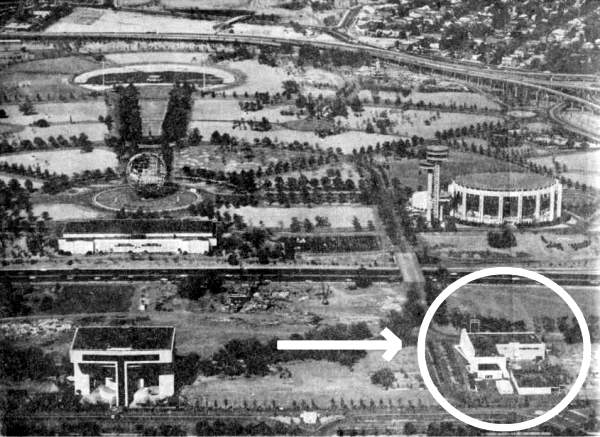
- Source: Sunday News,
June 26, 1966 Photo: Airview from NEWS plane
by George Mattson; Al DeBello, pilot
|
This aerial photograph, taken
after the Park reopened to the public in June, 1967, shows restored
Flushing Meadows-Corona Park just before it was turned over to
the City Parks Department by the World's Fair Corporation. The
Greyhound Pavilion has been demolished and a grassy plot is all
that remains.
What happened to the Greyhound
Pavilion? Craig Bavaro did some reasearch on this very question
and found the answer (along with the answer to "What Ever
Happened..." to a number of pavilions as he reported in his
essay "An
Almost Fond Farewell" featured here at nywf64.com). This is the perfect time to repeat Craig's findings:
... according to the Fair
records, this building was actually demolished in the early part
of 1967 in conjunction with the return of the Park to the City
of New York that summer. Curious enough is the fact that the
records clearly indicate early on that the Fire Department would
take over this building after the Fair. To that end the building
was indeed turned over to the Fire Department in late 1965 by
Greyhound, and Greyhound paid the City of New York the sum of
$37,000 as their portion of the conversion costs from their demolition
budget. At some point in 1966 the Fire Department determined
that, once again, the cost to upgrade the building to bring it
into compliance with New York City building codes was more than
it was worth. The records are silent as to why the upgrade costs
were not quantified early in the decision process as was so well
documented with most other structures considered. Ufortunately
they dragged their feet in notifying Fair officials of this fact.
And as such, by late 1966, Fair officials became increasing concerned
that this matter would not be resolved in time for the Fair Corporation
to avail themselves of the demolition contractors already on
site doing other work if the pavilion should need to be torn
down. To further complicate matters, during the same period,
someone in city government floated the idea of using this building
for some kind of poverty assistance program. Needless to say
Moses was not happy about this for he felt that a city park was
no place for such use. Finally, in early 1967, all parties agreed
that the building would be demolished and the orders were issued
to disconnect the utilities in preparation for the wreckers to
move in. It seems that in their rush to complete the work by
the re-dedication of the Park, the demolition company retained
to do the work caused some serious damage to the underground
electrical distribution system, even though Fair officials took
great pains to provide them with the necessary blueprints to
prevent this. Curiously, the record ends there and it was not
possible to tell who ended up paying for the necessary repairs
to the underground utilities.
|
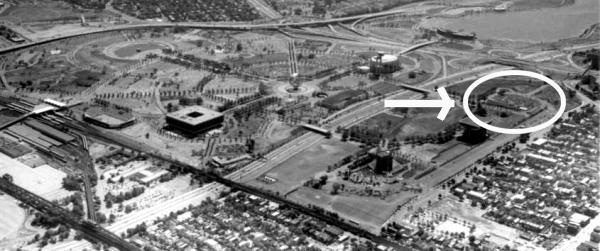
- Source: Photo courtesy
Bill Cotter Collection
|
| webmasters note: Ron Dominguez reports: In June 1967
I was very fortunate to go with my dad and brother to the fair
grounds for the dedication as a city park. While the event was
nice it was still a very painful experience for me since I was
a wild World's Fair fanatic. Seeing it all gone made me very
sad. As I wandered around the park I happened to spot what was
left of the Greyhound pavilion. On the day of the dedication
as a park, the wreckage of the pavilion being demolished was
STILL on the grounds. Most of the pavilion was still standing
and the area had a chain link fence around it. So I know from
actually being there that the demolition was late and a good
bit of the pavilion was still there that day. Ron Dominguez,
via email 2/08/2010. |
-
A Happier Fate...
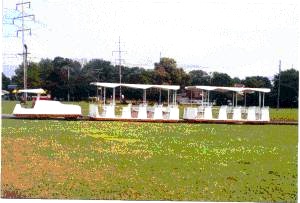 |
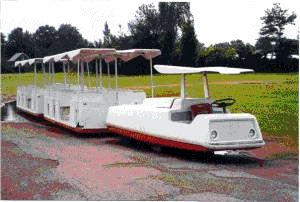 |
- Source: Photographs courtesyrMartin Biniasz, © Copyright
2000, All Rights Reserved
|
|
... awaited Greyhound's Glide-a-Ride trains
following the Fair. Many of them were sold to regional fairs
looking for a modern and convenient way to transport their fairgoers
around their grounds. For a time, Glide-a-Ride trains were even
used at the restored Flushing Meadows-Corona Park to transport
visitors around the Park.
The Glide-a-Rides shown above found a home
at the Erie County Fairgrounds outside of Buffalo, New York.
By August, 2000, these trains were nearing the end of their useful
life and the Erie County Fair was looking to find a buyer for
their Glide-a-Rides. It is unknown if a buyer was ever found.
By now, a full decade later, they too may have passed into New
York World's Fair lore.
|
-
-
An Escorter from the Fair serves
as a "Pushcart" of a different sort on Atlantic City's
famed Boardwalk.
SOURCE: Presented
courtesy Bill Cotter collection © 2010 Bill Cotter, All Rights
Reserved. See more images from Bill's fabulous collection
of World's Fair photographs at his website WorldsFairPhotos.com.
|
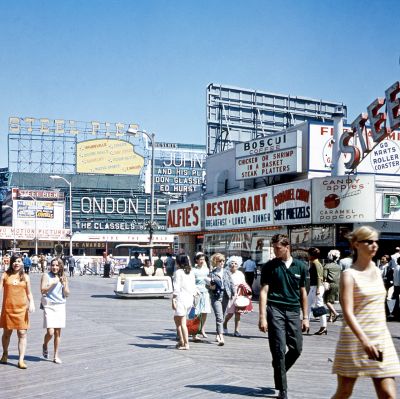
|
-
-
| webmasters note: Ron Dominguez writes: Somewhere in
the very early 1970's or late 60's I saw a picture of the mall
in Washington DC. In the photograph I saw in front of one of
the Smithsonian Museums one of the glide a ride trains. (It was
so distinctive as to not be missed). I "gathered" that
the company that did the riding tours of the mall purchased them
from Greyhound and were using them in Washington. So I am reasonably
certain that this is true. However, due to the many years since,
I can't swear 100% that it was true. I remember thinking it was
them and being quite certain but over the years, I can't quite
prove it now. So I think some of them wound up in Washington
DC. Ron Dominguez, via email 2/08/2010. |
-
-
|
Webmaster's note... I'd like to take this opportunity to
offer a special THANK YOU to Bill Cotter. Bill has always been
most gracious in allowing me to use images from his extensive
collection of 1964/1965 New York World's Fair photographs to
enhance nywf64.com.
His photos illustrate aspects of the pavilions and exhibits that
mere words cannot do justice to. It is one thing to see Greyhound's
mock up of an Escorter; it is so much better to actually see
it in action at the Fair -- complete with guides and guests.
Bill is a consumate collector of the Fair and he has also very
generously offered me items from his collection to include on
these pages. And he is the author of the Underground Home feature here at nywf64.com. Thank you, Bill, for the photos you
contributed to this feature and so many others. We all enjoy
them!
- Bill Young
- February, 2010
|
|